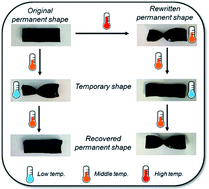Dual crosslinked metallopolymers using orthogonal metal complexes as rewritable shape-memory polymers†
Abstract
This work presents the synthesis and characterization of easily tuneable shape-memory metallopolymers. Furthermore, the structural design enables excellent rewriting properties. For this purpose, two different polymers were synthesized using either 2-ethyl hexyl- or butyl methacrylate monomers featuring both histidine and terpyridine ligands in their side chains. The addition of metal salt resulted in the selective formation of stable complexes with the terpyridine ligands (NiCl2 or FeSO4) and addition of a second metal ion led to labile ones with the histidine ligands (Zn(TFMS)2 or NiCl2). As a consequence, a dual supramolecular crosslinked metallopolymer network was formed, which was confirmed using Raman spectroscopy. Due to the use of different metal salts, it is possible to tune the stability of both complexes independently and, thus, the switching and rewriting temperature of the shape-memory polymer. Fixity and recovery rates up to 99% were obtained by this approach. Furthermore, thermo mechanical analyses revealed the rewriting possibility without reducing the shape-memory abilities.



 Please wait while we load your content...
Please wait while we load your content...